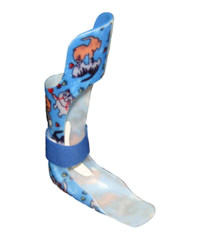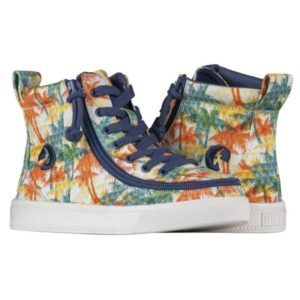Our shoes are more than our first line of defense against the dangers lurking on the ground below our bare feet – the sneakers, boots, and loafers we slip on and lace up every morning also celebrate our unique sense of style. At one time or another, we’ve all wanted to get our hands on a superstar’s new basketball shoes or a pair of designer red-soled heels.
 If you or your child wears a lower extremity orthotic, especially an ankle foot orthosis (AFO), the shoe department at your favorite store suddenly shrinks. While a wide-width athletic shoe may work for a brace, most adaptive styles are geared more to an octogenarian audience base.
If you or your child wears a lower extremity orthotic, especially an ankle foot orthosis (AFO), the shoe department at your favorite store suddenly shrinks. While a wide-width athletic shoe may work for a brace, most adaptive styles are geared more to an octogenarian audience base.
Thankfully, today’s forward-thinking brands realize they don’t have to compromise style for comfort and are designing easy-entry shoes that offer plenty of room for AFOs, but still reflect the hottest trends for 2022.
What to look for when shoe shopping
The most common misconception shoppers have is that you can make room for a brace by simply going up a shoe size or two. Although great in theory, this can be a serious problem if you wear a single orthotic. Sure, your brace may fit, but what you give up for comfort for one foot is stability for the other. When a shoe doesn’t fit properly, you set yourself up for a potential injury.
Instead, experienced orthotists recommend selecting shoes that embody universal design and are constructed to accommodate AFOs. As you hit the shoe stores or shop online, there are several important things to keep an eye out for:
 The right heel collar – Be sure that the heel of the shoe provides the proper support for your orthotic. A low heel may not be firm enough to provide ankle stability while one that’s too high or bulky can affect how well your AFO works.
The right heel collar – Be sure that the heel of the shoe provides the proper support for your orthotic. A low heel may not be firm enough to provide ankle stability while one that’s too high or bulky can affect how well your AFO works.- The perfect arch – Shoes that have a high arch or are flat-soled can make walking difficult since an AFO needs a subtle slant to keep the foot from slipping out. Unfortunately, that means you’ll have to say good-bye to both Chuck Taylor and Jimmy Choo.
- A removable sole – Because of its thin size, the innersole doesn’t seem to take up much space. However, once it’s removed, it’s amazing to see just how much extra depth there is for a smaller orthotic. The deeper the AFO sits in the shoe, the more comfortable you’ll feel.
- Adaptable features – Options like Velcro, expandable tongues, easy touch closures, and dual side zippers help ensure your shoes fit snugly around your orthotic so you no longer have to force your foot into a too-tight space.
Our orthotists’ top shoe choice
While there are numerous adaptive shoe brands on the market, the one we at Orthotic & Prosthetic Lab, Inc. steer clients to again and again is BILLY Footwear. Fashionable and functional, BILLY Footwear features innovative FlipTop technology, which incorporates a zipper that goes along the outside and around the toe so the shoe folds open like a book. The wearer can simply slide in their foot unobstructed, adjust the shoe around the orthotic, and zipper-pull the shoe closed.
Although BILLY Footwear is not specifically designed for AFOs, the line conforms to most small orthotics, while its wide options offer the space and depth for larger braces. Plus, BILLY Footwear is on top of every trend with styles for every member of the family, from leather sneakers and suede boots for men and women to colorful high-tops and rain boots for kids. So, whether you need a great pair of shoes for work, weekend errands or a night on the town, your orthotic stays in place and you stay comfortable.
Schedule your fitting with O & P
While it might not be a glass slipper, you can find your perfect fit with the right guidance from O & P. Not only will our orthotists custom fabricate an AFO to your specific needs, we’ll help you choose footwear that best supports your orthotic to ensure better alignment, greater stability and enhanced comfort. To learn more, contact O & P at 314-968-8555.
